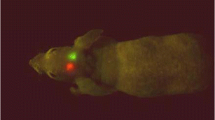Abstract
We have established stable, bright green fluorescent protein (GFP)- or red fluorescent protein (RFP)-expressing HT-1080 human fibrosarcoma clones. These cell lines showed similar cell proliferation rates and high-frequency experimental lung metastasis. The HT-1080-GFP and -RFP clones enable simultaneous real-time dual-color imaging in the live animal. HT-1080 cells were transduced with retroviral vectors containing GFP or RFP and the neomycin resistance gene. Stable transformants were selected stepwise with G418 up to 800 μl/ml. Subsequently, high GFP- or RFP-expressing clones, HT-1080-GFP or HT-1080-RFP, respectively, were selected. 3×106 cells from each clone were mixed and injected into the tail vein of SCID mice. The cells seeded the lung at high frequency with subsequent formation of pure green and pure red colonies as well as mixed yellow colonies with different patterns visualized directly on excised lungs. The lung metastases were also visualized by external fluorescence imaging in live animals through skin-flap windows over the chest wall. Lung metastases were observed on the lung surface of all mice. SCID mice well tolerated multiple surgical procedures for direct-view imaging via skin-flap windows. Real-time metastatic growth of the two different colored clones in the same lung was externally imaged with resolution and quantification of green, red, or yellow colonies in live animals. The color coding enabled determination of whether the colonies grew clonally or were seeded as a mixture with one cell type eventually dominating, or whether the colonies grew as a mixture. The simultaneous real-time dual-color imaging of metastatic colonies described in this report gives rise to the possibility of color-coded imaging of clones of cancer cells carrying various forms of gene of interest.
Similar content being viewed by others
References
Hoffman RM. Green fluorescent protein imaging of tumour growth, metastasis, and angiogenesis in mouse models. Lancet Oncol 2002; 3: 546–56.
Matz MV, Fradkov AF, Labas YA, et al. Fluorescent proteins from nonbioluminescent Anthozoa species. Nat Biotechnol 1999; 17: 969–73.
Heim R, Cubitt AB, Tsien RY. Improved green fluorescence. Nature 1995; 373: 663–4.
Chishima T, Miyagi Y, Wang X et al. Cancer invasion and micrometastasis visualized in live tissue by green fluorescent protein expression. Cancer Res 1997; 57: 2042–7.
Hasegawa S, Yang M, Chishima T et al. In vivo tumor delivery of the green fluorescent protein gene to report future occurrence of metastasis. Cancer Gene Ther 2000; 7: 1336–40.
Yang M, Baranov E, Jiang P et al. Whole-body optical imaging of green fluorescent protein-expressing tumors and metastases. Proc Natl Acad Sci USA 2000; 97: 1206–11.
Zolotukhin S, Potter M, Hauswirth WW et al. A ‘humanized’ green fluorescent protein cDNA adapted for high-level expression in mammalian cells. J Virol 1996; 70: 4646–54.
Yang M, Baranov E, Wang JW et al. Direct external imaging of nascent cancer, tumor progression, angiogenesis, and metastasis on internal organs in the fluorescent orthotopic model. Proc Natl Acad Sci USA 2002; 99: 3824–9.
Weissleder R, Ntziachristos V. Shedding light onto live molecular targets. Nat Med 2003; 9: 123–8.
Burgos JS, Rosol M, Moats RA et al. Time course of bioluminescent signal in orthotopic and heterotopic brain tumors in nude mice. BioTechniques 2003; 34: 1184–8.
Author information
Authors and Affiliations
Corresponding author
Rights and permissions
About this article
Cite this article
Yamamoto, N., Yang, M., Jiang, P. et al. Real-time imaging of individual fluorescent-protein color-coded metastatic colonies in vivo . Clin Exp Metastasis 20, 633–638 (2003). https://doi.org/10.1023/A:1027311230474
Issue Date:
DOI: https://doi.org/10.1023/A:1027311230474




